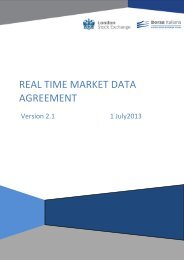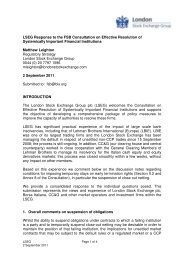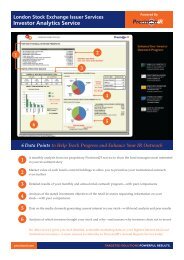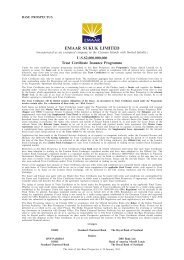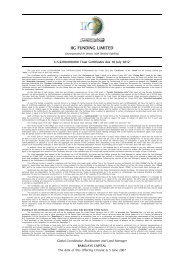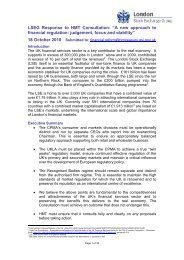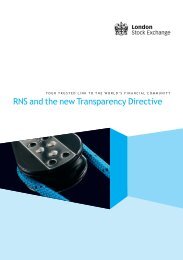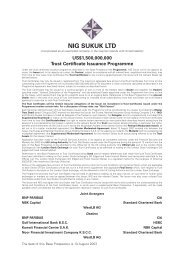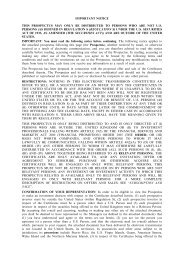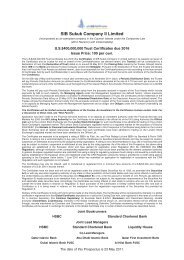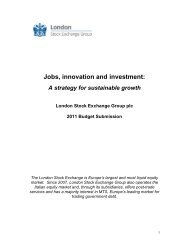Tabreed 06 Prospectus - London Stock Exchange
Tabreed 06 Prospectus - London Stock Exchange
Tabreed 06 Prospectus - London Stock Exchange
Create successful ePaper yourself
Turn your PDF publications into a flip-book with our unique Google optimized e-Paper software.
NATIONAL CENTRAL COOLING COMPANY (PJSC)<br />
NOTES TO THE CONSOLIDATED FINANCIAL STATEMENTS<br />
31 December 2005<br />
2.2 CHANGES IN ACCOUNTING POLICIES continued<br />
* IFRS 5 Non-current Assets Held for Sale and Discontinued Operations<br />
IFRS 5 requires a component of an entity to be classified as discontinued when the criteria to be<br />
classified as held for sale have been met or it has been disposed of. An item is classified as held for<br />
sale if its carrying amount will be recovered principally through a sale transaction rather than<br />
through continuing use. Such a component represents a separate major line of business or<br />
geographical area of operations, is part of a single co-ordinated major line of business or<br />
geographical area of operations or is a subsidiary acquired exclusively with a view to resale.<br />
The effect of the policy has resulted in the reclassification of the net carrying amount of AED 17.9<br />
million representing a district cooling plant from non-current assets to the heading of ‘assets classified<br />
as held for sale’ under current assets. The Company has committed to a third party for the sale of<br />
the plant at a value expected by the management to be in excess of its carrying amount at 31<br />
December 2005.<br />
2.3 SIGNIFICANT ACCOUNTING ESTIMATES<br />
The key assumptions concerning the future and other key sources of estimation uncertainty at the<br />
balance sheet date, that have a significant risk of causing a material adjustment to the carrying<br />
amounts of assets and liabilities within the next financial year are discussed below:<br />
Impairment of goodwill<br />
The Company determines whether goodwill is impaired at least on an annual basis. This requires an<br />
estimation of the value in use of the cash generating units to which the goodwill is allocated.<br />
Estimating the value in use requires the Company to make an estimate of the expected future cash<br />
flows from the cash generating unit and also to choose a suitable discount rate in order to calculate<br />
the present value of those cash flows. The carrying amount of goodwill at 31 December 2005 was<br />
AED 38 million (2004: AED 30 million). More details are given in note 12.<br />
Impairment of accounts receivable<br />
An estimate of the collectible amount of trade accounts receivable is made when collection of the full<br />
amount is no longer probable. For individually significant amounts, this estimation is performed on<br />
an individual basis. Amounts which are not individually significant, but which are past due, are<br />
assessed collectively and a provision applied according to the length of time past due, based on<br />
historical recovery rates.<br />
At the balance sheet date, gross trade accounts receivable were AED 168.4 million (2004: AED 114.5<br />
million), and the provision for doubtful debts was AED 7.8 million (2004: AED 6 million). Any<br />
difference between the amounts actually collected in future periods and the amounts expected will be<br />
recognised in the income statement.<br />
2.4 SIGNIFICANT ACCOUNTING POLICIES<br />
Basis of consolidation<br />
The consolidated financial statements incorporate the financial statements of the Company and each<br />
of its controlled subsidiaries as at 31 December each year. The financial statements of subsidiaries are<br />
prepared for the same reporting year as the parent company, using consistent accounting policies.<br />
Where subsidiary financial statements are drawn up to different reporting dates, adjustments are<br />
made. All significant inter-company balances, transactions and profits have been eliminated on<br />
consolidation.<br />
Subsidiaries are fully consolidated from the date of acquisition, being the date on which the Company<br />
obtains control, and continue to be consolidated until the date that such control ceases.<br />
Minority interest principally represents the interest in subsidiaries not held by the Company and are<br />
presented separately in the income statement and within equity in the consolidated balance sheet,<br />
separately from parent shareholders’ equity.<br />
F-18



